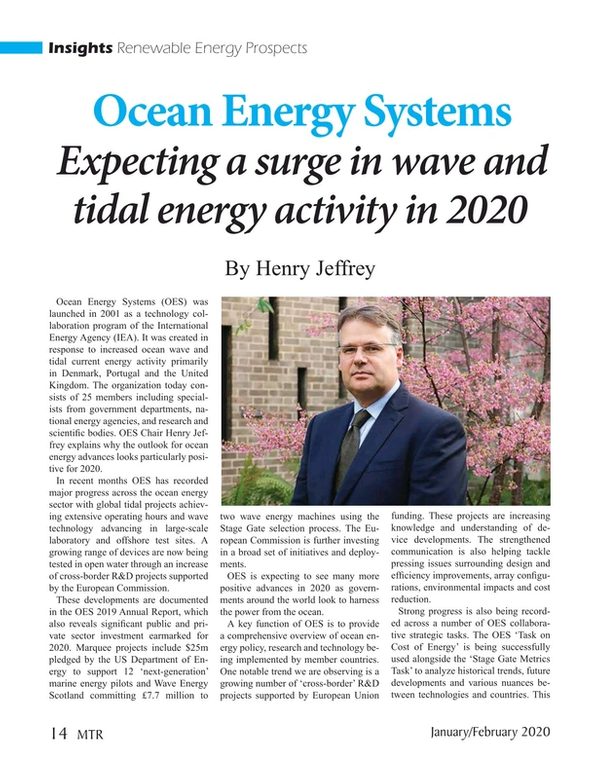
Ocean Energy: A Surge Coming in 2020
Ocean Energy Systems (OES) was launched in 2001 as a technology collaboration program of the International Energy Agency (IEA). It was created in response to increased ocean wave and tidal current energy activity primarily in Denmark, Portugal and the United Kingdom. The organization today consists of 25 members including specialists from government departments, national energy agencies, and research and scientific bodies. OES Chair Henry Jeffrey explains why the outlook for ocean energy advances looks particularly positive for 2020.
In recent months OES has recorded major progress across the ocean energy sector with global tidal projects achieving extensive operating hours and wave technology advancing in large-scale laboratory and offshore test sites. A growing range of devices are now being tested in open water through an increase of cross-border R&D projects supported by the European Commission.
These developments are documented in the OES 2019 Annual Report, which also reveals significant public and private sector investment earmarked for 2020. Marquee projects include $25m pledged by the US Department of Energy to support 12 ‘next-generation’ marine energy pilots and Wave Energy Scotland committing £7.7 million to two wave energy machines using the Stage Gate selection process. The European Commission is further investing in a broad set of initiatives and deployments.
OES is expecting to see many more positive advances in 2020 as governments around the world look to harness the power from the ocean.
A key function of OES is to provide a comprehensive overview of ocean energy policy, research and technology being implemented by member countries. One notable trend we are observing is a growing number of ‘cross-border’ R&D projects supported by European Union funding. These projects are increasing knowledge and understanding of device developments. The strengthened communication is also helping tackle pressing issues surrounding design and efficiency improvements, array configurations, environmental impacts and cost reduction.
Strong progress is also being recorded across a number of OES collaborative strategic tasks. The OES ‘Task on Cost of Energy’ is being successfully used alongside the ‘Stage Gate Metrics Task’ to analyze historical trends, future developments and various nuances between technologies and countries. This work allows us to chart and monitor the evolution of ocean energy costs and assess the impact of different drivers.
It is widely recognized that a rigorous technical review approach is required across the ocean energy sector, making use of improved evaluation methods and metrics. OES has been working closely with US Department of Energy, Wave Energy Scotland and the European Commission to achieve an internationally accepted approach of performance metrics for ocean energy development. This will be of high value to technology developers, investors and funders.
Meanwhile, the OES ‘Environmental Task’ is playing an important role continuing to collect, synthesize, and disseminate information. This provides access to knowledge and information related to research, monitoring, and evaluation of the environmental effects of ocean energy helping advance the industry. This task is supported by the publicly accessible online knowledge management system Tethys, developed by Pacific Northwest National Laboratory. Greater attention is however still required to assess potential job creation stimulated by the sector and to update projections for 2030 and 2050.
In recent years commercial interest in ocean energy has grown significantly at a global level. However, there are considerable investment costs and bottlenecks that need to be overcome. Globally, we are still waiting for clear market signals for ocean energy projects, which are vital for the industry to progress from demonstration to commercial projects. The ocean energy sector is at a crucial point where it must make best use of public funds, to deliver the right research, development and demonstration activity to build the confidence of the private investment community.
A great benefit of the OES network is that it enables nations to pool talent and resources to address global ocean energy challenges that no country can tackle alone. As an organization OES is firmly focused on uniting forces to advance research, development and demonstration of conversion technologies. Our underlying mission is to make ocean power a cost-effective, reliable and low-carbon source of energy generation for the whole world.
OES was established by International Energy Agency which carries out a comprehensive program of energy co-operation for its member countries. It examines the full spectrum of energy issues and advocates policies that will enhance energy security, economic development, environmental awareness and engagement worldwide.
Author Biography - Henry Jeffrey
Henry Jeffrey is a specialist in ocean energy roadmaps, action plans and strategies. He is a co-director for SuperGen ORE (Offshore Renewable Energy) UKCMER and leads the Policy and Innovation Group in the University of Edinburgh’s Institute for Energy Systems. He also chairs the European Energy Research Alliance (EERA) Ocean Energy Joint Program (JP) and collaborates on numerous European ocean energy projects. He is the current Chair of the International Energy Agency’s (IEA) Ocean Energy Systems (OES) programme, which is a government policy group responsible for supporting knowledge exchange and collaboration between countries and organisations active in the ocean energy sector.
Read Ocean Energy: A Surge Coming in 2020 in Pdf, Flash or Html5 edition of January 2020 Marine Technology
Other stories from January 2020 issue
Content
- Ocean Energy: A Surge Coming in 2020 page: 14
- Exploring Under The ice (& Keeping your AUV in one piece) page: 26
- Hybrid Autonomous Systems Evolve page: 30
- Marine Autonomy Above & Below the Water page: 30
- Good Undersea Vehicles Come in Small Packages page: 34
- Measuring the Hostile Ocean Beneath Hurricanes page: 40
- Subsea Robots in the Splash Zone page: 46
- UUV Manipulators: Get a Grip page: 52


